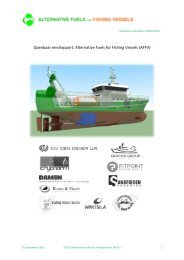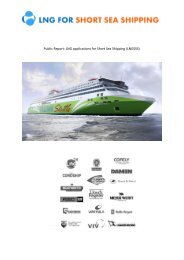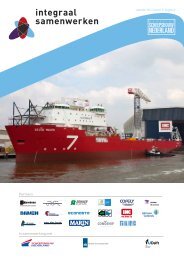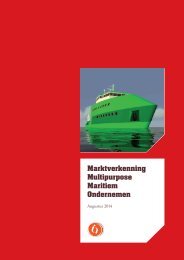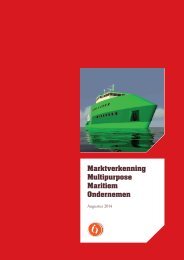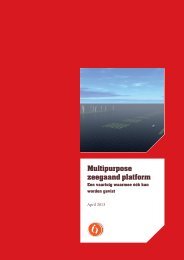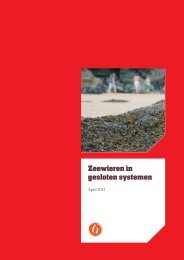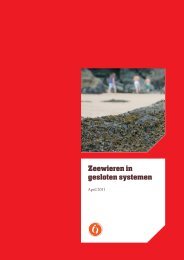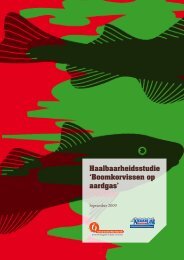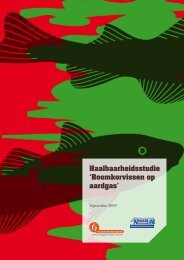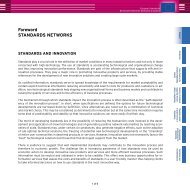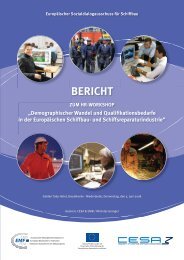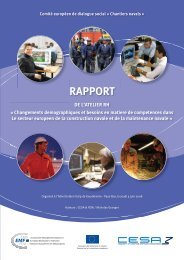Summary: Multi purpose Seagoing Platform (2013)
A feasibility study in the possibilities for multi purpose maritime entrepreneurship in the fishing industries.
A feasibility study in the possibilities for multi purpose maritime entrepreneurship in the fishing industries.
Create successful ePaper yourself
Turn your PDF publications into a flip-book with our unique Google optimized e-Paper software.
<strong>Multi</strong><strong>purpose</strong><br />
zeegaand platform<br />
Een vaartuig waarmee óók kan<br />
worden gevist<br />
April <strong>2013</strong>
<strong>Multi</strong><strong>purpose</strong><br />
zeegaand platform<br />
Een vaartuig waarmee óók kan worden<br />
gevist<br />
Dit rapport is in opdracht van InnovatieNetwerk opgesteld door:<br />
Pieter ’t Hart, Koers & Vaart B.V.<br />
Projectleider InnovatieNetwerk:<br />
Ir. J.A. Landstra<br />
Dit rapport is opgesteld in het kader van het thema ‘Noordzeevisserij’, concept<br />
‘<strong>Multi</strong><strong>purpose</strong> maritiem ondernemerschap’.<br />
Postbus 19197<br />
3501 DD Utrecht<br />
tel.: 070 378 56 53<br />
www.innovatienetwerk.org<br />
Het ministerie van EL&I nam het initiatief tot en financiert InnovatieNetwerk.<br />
ISBN: 978 – 90 – 5059 – 505 – 6<br />
Overname van tekstdelen is toegestaan, mits met bronvermelding.<br />
Rapportnr. 13.2.319, Utrecht, april <strong>2013</strong>.
<strong>Summary</strong><br />
43<br />
<strong>Multi</strong><strong>purpose</strong> seagoing platform – A vessel with which one can also<br />
fish<br />
Hart, P. ‘t, Koers & Vaart B.V.<br />
InnovationNetwork Report No. 13.2.319, Utrecht, The Netherlands,<br />
April <strong>2013</strong>.<br />
From ‘Fisherman to <strong>Multi</strong><strong>purpose</strong> Maritime Entrepreneur’ is an<br />
InnovationNetwork ambition for the fisheries sector. The challenge<br />
here is to broaden the fisheries business model from fisheries to other<br />
offshore activities. With their unique seamanship and knowledge of<br />
the sea, fishermen can do much more than fishing alone, and thus tap<br />
into new sources of income. This is important now that the economic<br />
position of fishermen is coming under pressure due to high fuel prices<br />
and the importation of farmed fish from the Far East.<br />
The range of possible subsidiary activities is broad and varied.<br />
Examples are marine and fisheries research, fish and seaweed farming,<br />
ancillary services to the offshore energy sector, seismic research,<br />
fishing for waste (such as plastic) and setting out buoys and beacons.<br />
This report aims to give fishermen an instrument for envisioning the<br />
potential activities they can undertake in order to make their business<br />
more viable and profitable. In view of the recent developments regarding<br />
LNG as a fuel, including its environmental benefits, application<br />
of LNG has been taken on board in the report.<br />
This report is a follow-up to earlier studies commissioned by<br />
InnovationNetwork into multi<strong>purpose</strong> maritime entrepreneurship.<br />
These looked at, among other things, examples in other countries<br />
(Norway) and approached the subject from a fisheries perspective.
44 Maritime consultancy Koers & Vaart was requested to develop a<br />
concrete business case for multi<strong>purpose</strong> maritime entrepreneurship<br />
from a broad sector-wide perspective. This took place in the framework<br />
of the EKO-vation project, in which the Ekofish Group and<br />
InnovationNetwork work with various partners on a revolutionary<br />
multi<strong>purpose</strong> seagoing platform.<br />
Whether it is profitable for fishermen to invest in offshore activities<br />
other than fishing depends on many factors and the answers can vary<br />
widely according to the specific nature of the fishing company and the<br />
ship. A whole series of questions arises. What activities other than<br />
fishing would the fisherman like to tackle? How much time is he<br />
prepared to allocate to these activities? What sailing speeds does he<br />
expect to need and what are the implications in terms of fuel<br />
consumption? And all these questions are also closely related.<br />
This business case has led to a computation model, into which the<br />
fisheries entrepreneur can enter his individual wishes and business<br />
profile. He can also vary these data to explore the various options. The<br />
outcomes will provide an approximate indication of the viability of<br />
each option. Clearly, further details need to be worked out before<br />
making definite business decisions.<br />
In view of the growing interest in LNG as a transport fuel, the<br />
computation model also contains a separate page which shows the<br />
estimated payback time for an LNG installation given the selected<br />
activities, fuel consumption, number of sailing days, and estimated<br />
prices of diesel and LNG.<br />
The computation model (spreadsheet) can be found at:<br />
http://tinyurl.com/cdawbje.<br />
Conclusions and recommendations<br />
<strong>Multi</strong><strong>purpose</strong> maritime entrepreneurship opens up opportunities for<br />
the fisheries entrepreneur to broaden and strengthen the economic<br />
base of his business. Income increases, while investment costs and<br />
operating expenses rise less quickly. The fuel costs that form a substantial<br />
portion of the operating expenses can be reduced by almost 10%<br />
assuming optimal use of the ship.<br />
The fisheries sector is currently exploring how costs can be saved by<br />
sailing with smaller ships or reducing the speed of existing ships.<br />
However, a higher speed makes for greater flexibility and allows for a<br />
drastical increase of the ship’s versatility.<br />
This calls for a ship that can be easily adapted to the changing wishes<br />
and requirements of prospects and customers. Following the example<br />
of large offshore ships with large working decks, a market is also emerging<br />
for smaller multi<strong>purpose</strong> vessels.<br />
LNG as an alternative fuel is mainly interesting with a high ship capacity<br />
utilization and in situations requiring higher sailing speeds.<br />
Payback times vary from 4.5 years with a higher capacity utilization to<br />
8 years with a lower capacity utilization.<br />
In addition, the application of LNG helps to give the fisheries sector a<br />
greener reputation, which is increasingly important for the image of<br />
fish in the market.
It is recommended to enter into talks with various representatives<br />
from the maritime sector at an early stage and to explore the opportunities<br />
for concluding long-term contracts in order to realize the higher<br />
capacity utilization of the multi<strong>purpose</strong> vessel as quickly as possible.<br />
It is recommended to build a strong position with partners into new<br />
markets alongside fisheries activities and to continue developing,<br />
designing, building and commercializing the multi<strong>purpose</strong> concept.<br />
45




